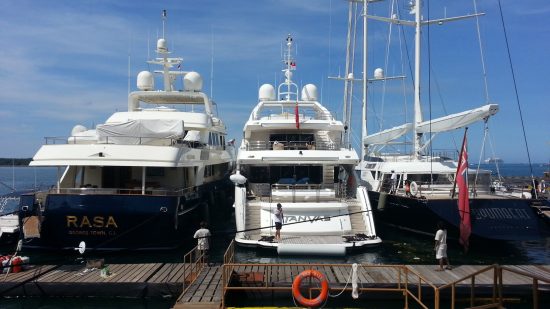Very little tops the stress a superyacht Captain suffers when backing a 60 metre into a 45 metre slot in front of Café de Paris while everyone in the whole of St Tropez looks on, each willing the Captain to make a mistake
Now, aiming to tackle one of yachting’s most stressful manoeuvres Volvo Penta has revealed an advanced self-docking solution, targeted for launch in 2020.
The pioneering self docking technology was put to the test recently when it was used to automatically dock a motoryacht in between two Volvo Ocean Race 65 yachts.
In a live demonstration, a 18 metre motor yacht fitted with the technology skilfully manoeuvred itself into the tightest of spaces between two of the Volvo Ocean Race 65 racing yachts.
The unveiling of the pioneering self-docking yacht technology is the latest in Volvo Penta’s on going ‘Easy Boating’ philosophy to make boating simple, enjoyable and accessible to more people.
At its heart is the joystick-controlled Volvo Penta Inboard Performance System (IPS)*, a complete and integrated propulsion system – from the helm station, via the engine, all the way to the propellers.
Narrow berths, changing wind and sea conditions and congested marinas will all soon be less of a challenge when docking. This is thanks to the responsiveness of the Volvo Penta IPS system, coupled with sensors and advanced navigation processing power.
Just as the system helps get the boat into the dock easily and safely, it can also enable it to securely take-off from the dock in an automated fashion.
Prototypes of Volvo Penta’s self-docking technology are currently undergoing development trials. The automated docking capability comes due to the on board electronic vessel control system (EVC), which computes steering and drive calculations in relation to the boat’s actual position and four sensors sited on the intended berth.
Automating the docking process involves three distinct phases. Firstly, as the boat nears its berth, the system recognizes that it has entered a ‘catch zone’ and sends out a signal to the captain that it is ready to dock. Once the captain has activated the self-docking function, the boat is then (aided by GPS), automatically moved into a ‘docking ready’ position. Once the captain has initiated the final stage, the system uses a combination of GPS and sensors, both those fitted onboard and additional sensors fitted to the destination dock to automatically move the boat into a safe berth.
Sensors on the berth help guide the yacht safely into its docking position.
The initial focus for Volvo Penta’s self-docking system will be individuals who can install the system on their own private docks. Longer term, it is believed that the technology will be of considerable interest to harbours and marinas, allowing IPS-equipped boats fitted with the system to dock in complete safety and accuracy.
An additional future scenario for the self-docking system is that it could be integrated with Volvo Penta’s Easy Connect application (app). The app could allow users to check if the nearest marina is equipped with the appropriate self-docking technology – or even perhaps use it to secure a parking space.
Safety is a primary factor in the on going development of the feature and, as with similar ‘self-parking’ technology in the automotive world, Volvo Penta’s docking system is not designed to be fully autonomous. While the system will also feature surround sensors that provide anti-collision alert and avoidance, the captain needs to remain at the helm during the docking process, ready to intervene if necessary.
Watch the first public self-docking yacht park between two Volvo Ocean 65 sailing yacht:
http://t.lt02.net/q/RzlRKKz2r3X8-zFfvL7FbbdxkZ8R0qgqIgT0TW1XSdIybLfZYmDs0ZVYQ5Fw

